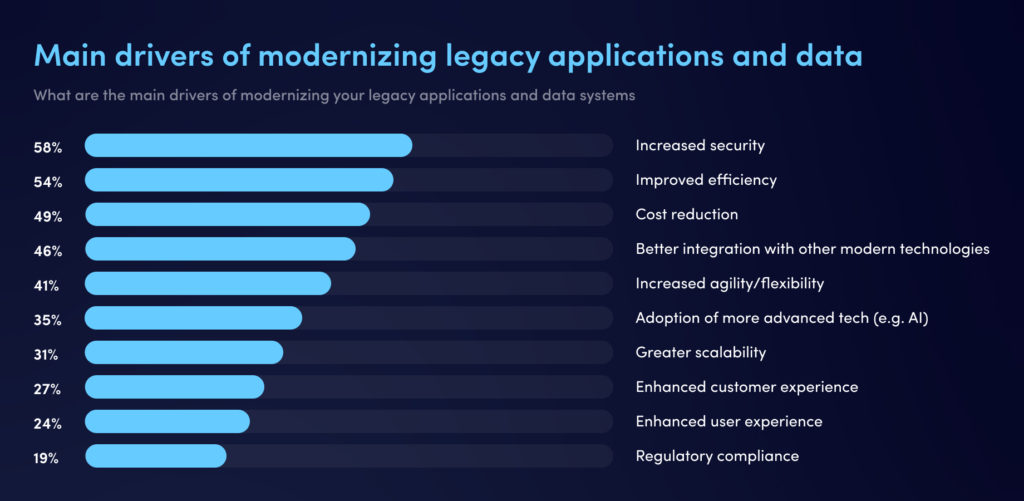By Milovan Milic, CEO of Devtech
A recent study by McKinsey shows that a staggering 70% of all digital transformation projects fail. This statistic is a sobering reminder that the journey is rife with challenges that can derail even the most well-intentioned initiatives. Businesses can’t afford to be mere spectators in an era where digital disruption is the norm. Becoming a digital innovator is vital to remaining relevant in the face-paced world of technology.
By 2024, more than 45% of IT spending is projected to shift from traditional legacy systems to cloud-based solutions.
Gartner, Inc.
The cloud is at the heart of successful digital transformation strategies. This trend indicates a market that is increasingly ready to transition from outdated IT infrastructures to more advanced cloud-native technologies. Yet the journey from legacy to cloud-native is not easy. In our work with emerging companies and Fortune 500 enterprises worldwide, we see five common pitfalls that are addressable through the right cloud migration approach.
1. Map cloud migration to business strategy and vision
A fundamental error in the cloud migration journey is a need for a well-defined strategy and vision. According to Unisys, over one-third, (37%) of U.S. businesses fail to realize notable benefits from cloud computing, mainly because they need to integrate their adoption plan as a core part of their broader business transformation strategy. Without a clear roadmap that aligns with business objectives, projects often quickly devolve into disconnected initiatives, leading to inefficiencies, wasted resources, and missed opportunities.
It’s critical to thoroughly understand business drivers, objectives, market trends, and customer needs. With this insight, you can identify how cloud solutions can enhance operational efficiency, scalability, and customer experiences. Then, craft a comprehensive plan that outlines the cloud migration strategy, resource allocation, and projected outcomes

Ongoing communication with key stakeholders is vital to ensure a shared understanding of how cloud migration and modernization will drive value. Engage teams through regular updates and workshops to foster a collective commitment to the transformation process. Measure and quantify the impact of cloud adoption on key performance indicators to demonstrate the contribution to the business’s bottom line. By consistently aligning cloud initiatives with the business vision, digital innovators can position their companies for sustainable growth, competitive advantage, and technological resilience.
2. Don’t underestimate the complexity
Imagine building an IT system/platform over a 10 to 20-year span. By now, it’s likely still a monolith structure, riddled with significant technical debt and accompanied by limited or outdated technical documentation. As a CIO or CTO, you own modernizing this behemoth – the nucleus of your company’s intellectual property. Driven by intense business pressures and the allure of quick wins, you ambitiously earmark a six-month timeframe for the project’s initial phase. Half a year seems ample on paper, creating the illusion that monumental progress is doable. However, the reality of such undertakings often diverges dramatically from initial expectations.
Companies can avoid the pitfalls of haste and help ensure successful cloud migrations by comprehensively assessing the existing infrastructure, applications, and data. This evaluation helps identify potential challenges and create a well-structured migration plan. Further, consider adopting a phased approach, where critical workloads are migrated incrementally, which allows for thorough testing, troubleshooting, and optimization, and helps minimize the risks associated with a rushed migration. Regular communication, training, and involving relevant stakeholders also help ensure a smoother and more successful transition to the cloud.
TSB Bank in the UK undertook a significant IT migration process to move customer data from an old system managed by its former owner, Lloyds Banking Group, to a new one managed by its Spanish owner, Banco Sabadell. The bank had assured customers that this shift would be smooth. Upon execution, many customers found themselves locked out of their accounts; some reportedly had access to other customers’ details, while others claimed money had disappeared from their accounts. This IT fiasco was partly attributed to underestimating the complexity of such a large-scale migration, leading to significant reputational damage and regulatory scrutiny.
To address these challenges, invest in in-depth research and analysis of the migration approach and develop a thorough migration plan that covers all identified complexities. The Bloomberg article mentions, among other things, that “Due diligence in the discovery and planning phases is critical “. Collaborate with stakeholders for alignment and buy-in, do the research, and identify potential issues. Importantly, seek expert guidance for valuable insights and set realistic timelines accommodating unforeseen complexities. By following these steps, executives can navigate the intricacies of IT modernization and cloud migration, reduce wasted resources, and achieve successful outcomes.
3. Ensure the right skillsets
Ensuring a successful migration to the cloud hinges on having a team with the right blend of expertise in legacy systems and modern cloud-native technologies. This is often a challenge as internal teams have predominantly worked on a legacy, outdated monolith behemoth and have yet to acquire the relevant experience of cloud-native tech at scale.
One-third of respondents say they lack the expertise needed for cloud modernization.
Rackspace
Ensuring successful cloud migrations requires melding legacy system understanding with modern cloud-native expertise. Many businesses entrenched in legacy systems grapple with this shift. Symantec, a cybersecurity giant historically dominant in antivirus solutions, faced the complex task of transitioning to cloud-native services in a landscape with agile startups. Their challenge was technological and involved aligning their seasoned team with evolving cloud paradigms. Symantec’s journey exemplifies the intricate dance between leveraging deep-rooted expertise and adapting to the demands of modern cloud-native transformations.
To ensure the right skillsets, identify platform-specific expertise gaps and assemble a multidisciplinary team. Cloud architects devise migration strategies and architecture, while cloud engineers manage implementation and integration. DevOps engineers streamline collaboration, security experts handle risk assessment and compliance, and data professionals manage migration and optimization. Change management specialists are also critical to facilitate the cultural shift. Agile methodologies are vital and should be supplemented by external partners if needed. Balancing internal and external expertise, fostering a learning culture, and monitoring performance ensure alignment with cloud strategy.
4. Don’t neglect security and compliance
The complexity of modernizing legacy systems is compounded by “Security by Design” concepts. Consider the case of FireEye, one of the largest cybersecurity ISVs in the US (now part of Trellix). In 2020, FireEye’s cloud acquisition marked a strategic investment to accelerate its transformation as a cloud cybersecurity player. However, a sophisticated security breach, where attackers targeted and accessed FireEye’s internal systems a significant setback and derailed the company’s plans.
Additionally, Capital One’s significant data breach, which exposed the personal information of more than 100 million customers, was caused by a cybercriminal exploiting a vulnerability in the bank’s cloud infrastructure. While Capital One was migrating a significant portion of its IT operations to the cloud, the breach highlighted the complexity and potential risks of such a transition. The breach raised concerns about security measures, access controls, and overall risk management in the cloud environment.
In cloud-native settings, 41% of organizations choose to weave security into every stage of software development.
Palo Alto Networks
These incidents underscore the importance of integrating robust security measures from the onset of modernization efforts. Transitioning to cloud-native computing demands a distinct security approach compared to legacy software systems. In cloud-native environments, 41% of organizations favor integrating security solutions throughout the software development lifecycle. Companies looking to modernize successfully should prioritize secure architectural design, continuously monitor for vulnerabilities, and invest in cutting-edge security tools to protect against breaches as they transition to the cloud.
5. Avoid rushing the process
The mantra for every company should be test, refine, then test again, and test some more. Cybersecurity giant Trend Micro faced the consequences of moving too quickly a few years ago. In their keenness to launch a cutting-edge cloud security solution, they rolled out an update with unforeseen vulnerabilities. Attackers exploited these security flaws and were able to get unauthorized access to customer data.
In digital innovation and migrating to the cloud, haste can cost dearly, emphasizing the need for diligent planning, sound execution, and rigorous quality assurance over sheer speed.
The journey from legacy systems to cloud-native environments carries significant challenges in the swiftly evolving digital landscape, underscored by the sobering 70% failure rate in digital transformation projects. The central role of the cloud in successful transformations is clear, yet pitfalls loom for every company.
To help ensure success, understanding how to navigate five common pitfalls is critical. Alignment with business vision is paramount. Underestimating complexity, witnessed in incidents like the TSB Bank scenario, necessitates meticulous planning, expert guidance, and comprehensive testing. The right skillsets are crucial, as legacy-to-cloud shifts challenge established teams. Pay attention to security and compliance, as impatience can lead to errors.
A judicious approach, integrating strategy, expertise, security, and pace, is essential to navigate this complex journey successfully.


